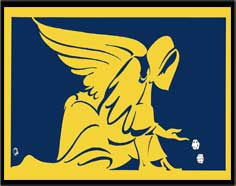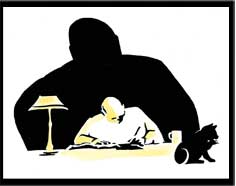Abraham Saffron was one of the most powerful and successful of Sydney’s crime bosses, and also the most unusual. Most of his money came not from standing over other illegal businesses, but from owning and running his own entertainment venues. It just so happened that much of the entertainment he offered – mainly illegal alcohol and prostitution – was illegal. Because of the need to protect his many establishments, and due to his own business skills, he was a key underworld figure in the corruption of politicians and police for a period of several decades.
It was not this, though, that made him a public figure for much of his life. For this he had to thank two things, a memorable 1951 photo of him at one of his nightclubs, shot in fetching manner through the legs of a female performer, and the tag “Mr Sin” attached by a state attorney general in 1976. These two identifiers were to be run below his name in hundreds of articles and books over the years. He became the public, and to a degree the deceptively benign, face of organised crime.
Saffron was born in Sydney in 1919. Like most serious criminals, he chose to serve his country during World War II on the home front. By the second half of the 1940s he owned a number of pubs and nightclubs. His fortune was founded on flouting the war and post-war restrictions on the supply and serving of beer. Saffron would illegally transfer grog from his hotels to his clubs, where it would be sold at night for enormous mark-ups. (For years legitimate venues had to stop selling alcohol at 6.00pm.)
This was his basic business model right through the 1950s, although he diversified. He attracted people to his clubs by bringing out top American singers such as Frank Sinatra, and made extra money from the prostitution that occurred on some of his premises. He expanded into other states and evaded official efforts to restrict his activities by taking out most of his liquor licenses in other people’s names. Gradually, though, a lot of the profit went out of alcohol as quotas were abolished and opening hours were extended to 10.00pm in 1955.
A sex addict himself (one of the few prosecutions he faced was for participating in an orgy at Palm Beach), Saffron sold pornography and provided blue movies to cinemas. At his height he had interests in 100 brothels (known for a while as “massage studios”) and 50 nightclubs around the country. In 1960 he opened Australia’s first strip club, the Staccato, in Kings Cross, soon followed by the iconic Pink Pussy Cat and many others. He took over the lease of Les Girls and later financed gay clubs.
For the next two decades he owned many of the premises along Darlinghurst Road, Kings Cross (the so-called “Golden Mile”) and made enormous profits from these and his other businesses, which he ploughed into a growing property portfolio. He hid his links to many insalubrious establishments behind a screen of over 100 companies. His criminal career went into decline in the 1980s when pornographic videos (and home recorders) and heroin changed the Cross. Still, his worth was estimated at over $20 million when he died in 2006, making him possibly the most financially successful Australian criminal, outside of the area of white collar crime
The extraordinary thing about Saffron is that although he was engaged fairly publicly in a range of criminal activities for over 40 years, he was almost never troubled by the police until 1987, when (as was to happen to Lennie McPherson later) he was charged by the federal National Crime Authority. (Compared to the state police, the feds were relatively honest.) He was convicted of tax evasion, and went to gaol for 17 months.
Saffron had immunity from prosecution for so long because he was bribing politicians and police, with money, entertainment, and sexual favours.
The extent of Saffron’s power is indicated not just by the dearth of prosecutions, but by the fact that almost no New South Wales politician mentioned him publicly, even with parliamentary privilege. It was in the South Australian parliament he gained the name Mr Sin, but locally he seems to have done favours for enough powerful people for the rest not to make waves.
It is impossible to know the full extent of Saffron’s criminality, as by the end he was linked to a vast array of general activities, including extortion, arson and insurance fraud. The Costigan royal commission in 1984 found he was involved in drug dealing and the operation of gambling establishments, and that he used gambling debts, and evidence of sexual indiscretions, as a way of controlling men of influence. One in Saffron’s debt was Lionel Murphy, at one time federal attorney general, who had sex with young women in one of Saffron’s Kings Cross premises.
After Saffron’s death his son Alan said, “my father was a visionary and the founder of the modern entertainment industry in Australia, providing fabulous clubs, pubs, gambling and sex to the public – all of which is legal today.” There is some truth in that. Abe Saffron, like Al Capone – another criminal who went to gaol for tax evasion – became wealthy from prohibition.
MAIN SOURCES: The Prince and the Premier by David Hickie; Connections by Bob Bottom; Gentle Satan by Alan Saffron; Mr Sin by Tony Reeves; The Usual Suspect by Duncan McNab; articles in the Sydney Morning Herald by Kate McClymont.











You must be logged in to post a comment.